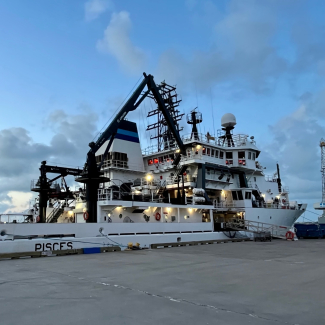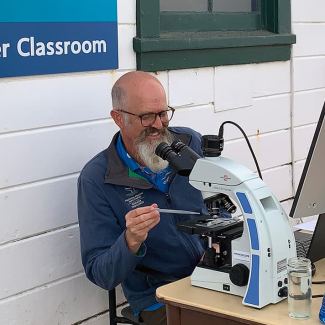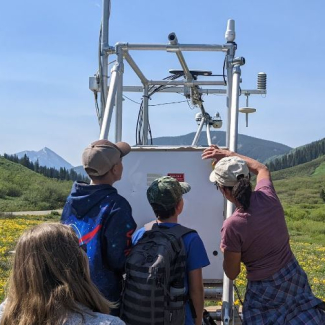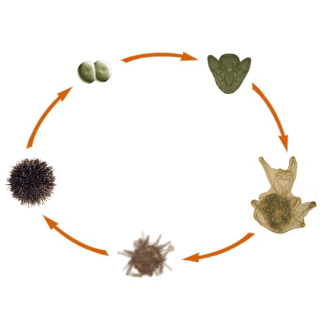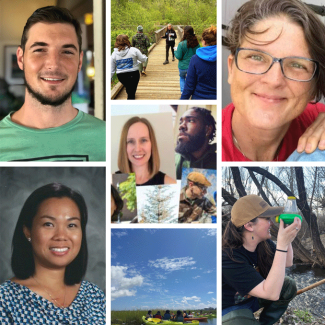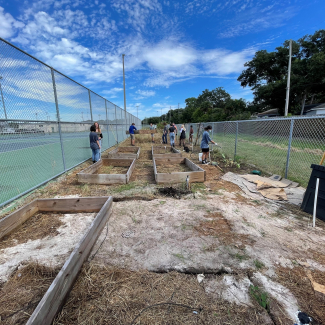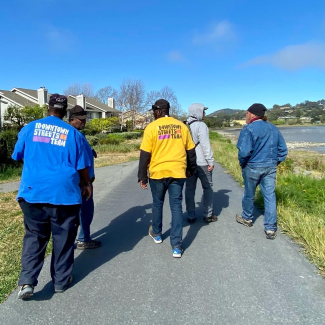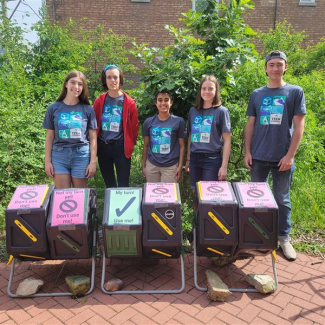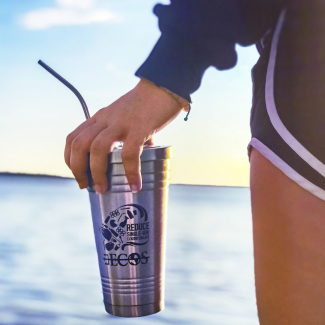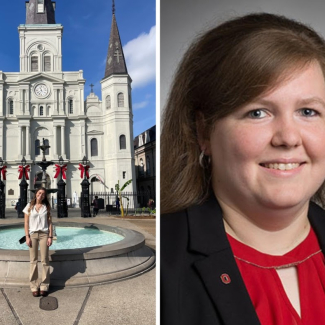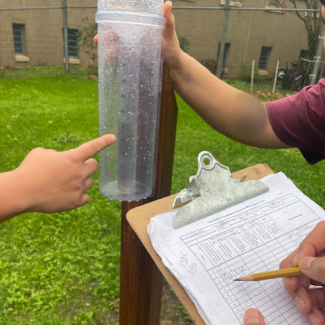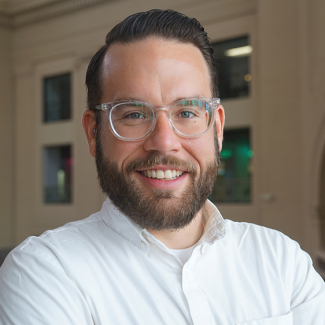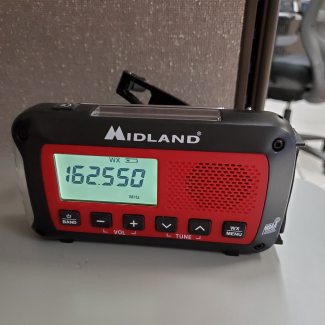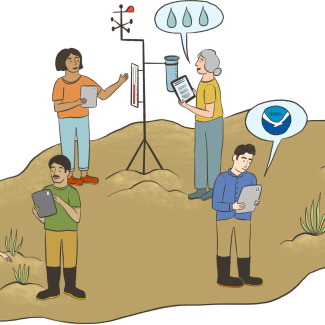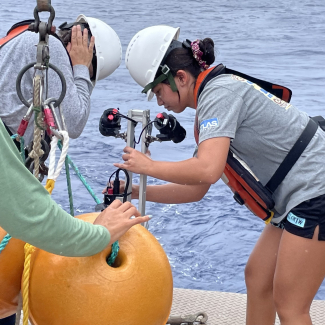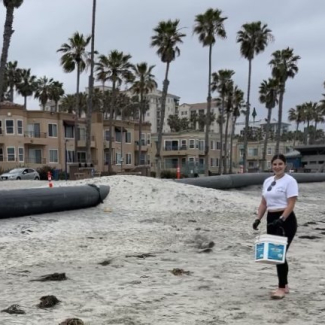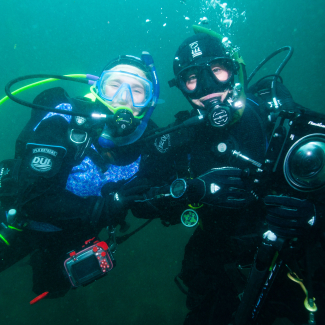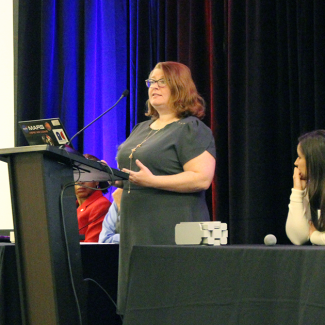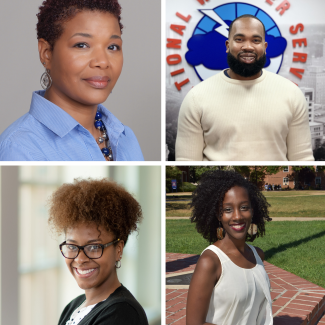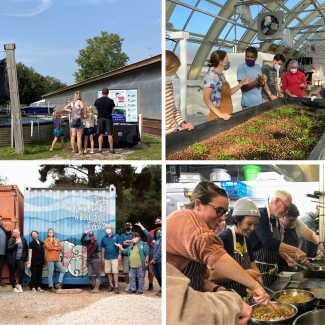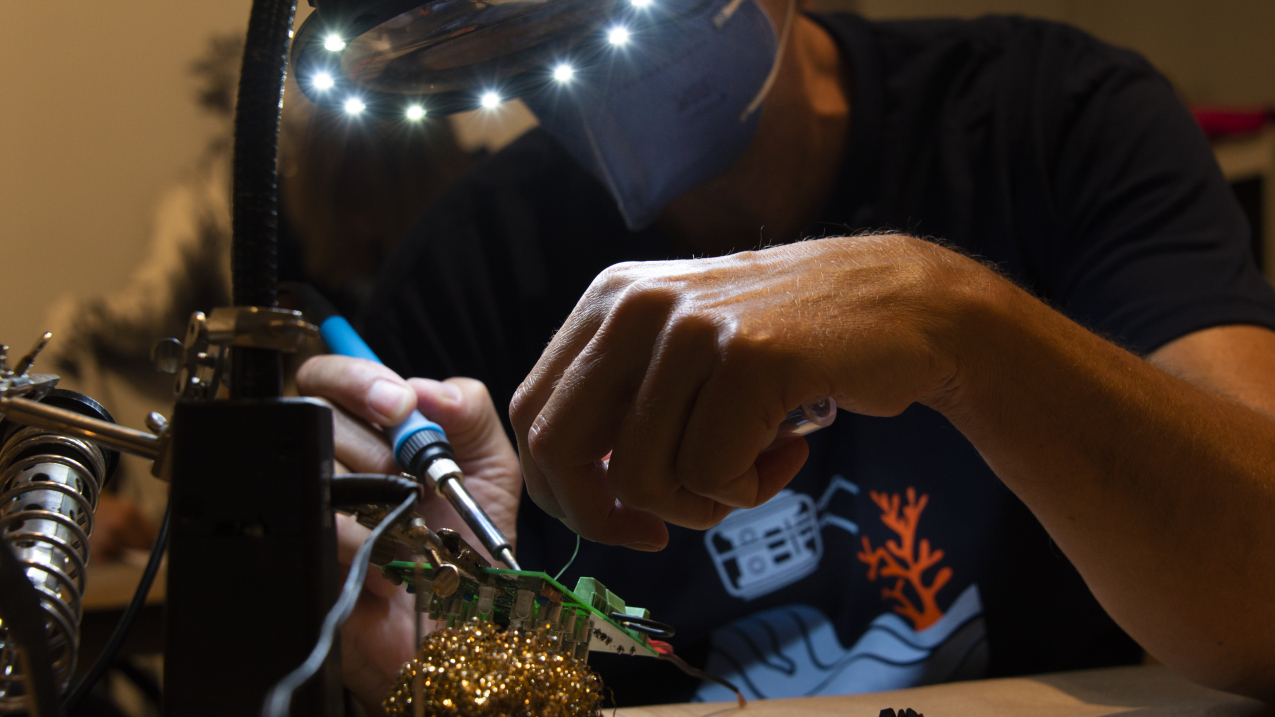
Teacher at Sea alumnus Jeff Miller (2015) solders an ROV control box circuit board during the Teacher at Sea Alumni Association's Project ROVe: Design and Build workshop in July 2022. Alumni who completed an online ROV introductory course through the Association earlier in the year were eligible to participate in this hands-on ROV build workshop over the summer. (Image credit: Ryan Hawk)
2022 NOAA Education Accomplishments Report
Introduction
Goal 1: Science-Informed Society
Goal 2: Conservation and Stewardship
Goal 3: Ready, Responsive, Resilient
Goal 4: Future Workforce
Goal 5: Organizational Excellence
NOAA takes an “all hands on deck” approach to education. Our educators and partners work in different offices, programs, states, and even countries, covering topics that span from the surface of the sun to the depths of the ocean. NOAA Education reaches preschoolers through retirees both inside and outside the classroom. This report highlights some of many accomplishments that the NOAA Education Council and broader NOAA Education community completed in fiscal year 2022.
From the director
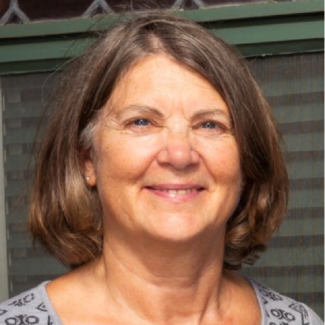
Dear partners and friends of NOAA Education,
On behalf of the NOAA Education community, I’m pleased to present our 2022 Accomplishments Report. This report highlights the significant role that education plays in meeting NOAA’s mission of science, service, and stewardship.
This year, we introduce you to graduate students who helped put together the first ever inventory of federal climate resources, efforts by the National Weather Service to bring weather awareness and resiliency to Amish communities, and a new mini-grant program that engaged underserved and underrepresented communities in ocean exploration careers. Through these efforts and many more, the NOAA Education community continues to serve and inspire people across the country and work towards a more Climate-Ready Nation.
Since 2013, we have collected data about the number of people and organizations we reach. These common measures report outputs and outcomes from education programs across NOAA and help communicate the great work our educators do. This year, we’re piloting a new metric to capture our collective efforts to engage participants in environmental actions. Whether people are restoring local habitats or using their voices to raise awareness of weather hazards in their communities, these actions play an important role in how people can impact the environment and how the environment can impact people.
We are grateful for the continued support from our dedicated partners and our growing connection with the people we serve. Through the efforts of the collaborative organizations, talented students, and passionate educators we work with, we are able to accomplish so much in support of NOAA’s mission. We look forward to working with you to enhance our education efforts in the years to come.
Sincerely,
Louisa Koch
Director of NOAA Education
NOAA Education by the numbers
*2022 was the pilot year for this metric. Some programs did not collect or submit data.
NOAA Education enables people to explore the world around them, broaden their horizons, and learn more about environmental issues. This year, we highlight programs that helped students, educators, and the public develop a greater understanding of Earth and its varied systems.
In brief
- Happy 50th Anniversary to the National Marine Sanctuary System! During the 50th campaign, NOAA’s Office of National Marine Sanctuaries organized 40 site-based events involving more than 12,000 people, developed 20 new educational resource collections, created new educational posters, held virtual learning webinars, and partnered with the New England Aquarium and the Georgia Aquarium on new exhibits. They also worked with the U.S. Postal Service to release a commemorative National Marine Sanctuary stamp series.
- The National Air and Space Museum offsite link premiered the One World Connected offsite link exhibit, which included instruments from NOAA's National Environmental Satellite and Data Information Service Geostationary Operational Environmental Satellites. This installation tells the story of how flight fostered two momentous changes in everyday life: the ease in making connections across vast distances and a new perspective of Earth as humanity’s home.
- The Teacher at Sea Alumni Association offsite link took on the theme of Art and Science Integration offsite link to celebrate the ways that educators use the arts to engage their students and communities in the content and concepts that are important to a science literate society.
- New product alert! Modeling Marine Ecosystems with Virtual Reality, developed by NOAA’s National Ocean Service and NOAA Fisheries, helps high school students explore how scientific models work using the Virtual Ecosystem Scenario Viewer, an interactive virtual reality model that NOAA and other scientists use to visualize changing ocean ecosystems.
Featured stories
NOAA Ocean Exploration, in collaboration with the National Marine Sanctuary Foundation, developed a mini-grant program to support underserved and underrepresented communities in engaging in various ocean exploration careers and build the capacity for STEAM — science, technology, engineering, art, and math. These grants funded up to $25,000 to each of seven projects. From integrating Native Hawaiian worldviews on ocean literacy and stewardship to incorporating ocean exploration data in undergraduate biology lab courses, each project aimed to build a more equitable ocean exploration workforce pipeline.
In 2020, health and safety restrictions of the COVID-19 pandemic placed the NOAA Teacher at Sea Program on hold. Now, teachers are setting sail once more to work with world-renowned NOAA scientists and bring what they learn to their classrooms. The NOAA Teacher at Sea Program offers educators a once-in-a-lifetime opportunity to get hands-on experience and a unique look into oceanic and atmospheric research. "We are thrilled to be sailing teachers once more on NOAA research surveys for this unique research experience," says director Jennifer Hammond. Meet each of the educators who joined NOAA scientists to learn how to collect data that contribute to our understanding of the ocean and Great Lakes.
A team from Greater Farallones National Marine Sanctuary turned to the help of tiny living organisms – plankton – to help celebrate the national marine sanctuaries’ monumental 50th anniversary. In collaboration with NOAA’s Teacher at Sea Alumni, the team took plankton on a “road trip” through cyberspace this year, with a goal to teach a plankton program in every state. “This program is reaching youth now so they can appreciate the importance of conserving life in the ocean, even when it's so small that it’s invisible to the naked eye,“ said Justin Holl, visitor center manager for Greater Farallones and Cordell Bank national marine sanctuaries.
The Colorado River Basin is a primary water source for more than 40 million people across several states and Tribal Nations. However, a 20-year drought and warming caused by climate change have significantly impacted water availability resulting in the first-ever declaration of shortage conditions by the Bureau of Reclamation in 2021. NOAA Research and its partners launched the Study of Precipitation, the Lower Atmosphere and Surface for Hydrometeorology (SPLASH) to better understand how precipitation forms in complex, high-altitude terrain and help improve weather forecasts and runoff estimates. Using the power of illustration to educate and inform the public about SPLASH, NOAA Research helped transform some of the instruments into superhero characters that have special powers to capture critical environmental measurements.
In collaboration with academic partners, the NOAA Ocean Acidification Program (OAP) supported the development of a free, intuitive, and extensive tool that can be accessed through many devices (mobile or desktop) and can provide students with laboratory experiences that develop their skills and interest in STEM topics. Virtual education tools like these are incredibly important to reach students and educators globally. Open-access activities for individual, group, or classroom use are a valuable outreach and education strategy for students all over the world that may not have the resources to practice these skills in person. To date, more than a million people have used these virtual labs.
Everyone has a part to play in protecting our coastal and marine resources. NOAA Education works to ensure that people have the resources they need to make informed choices that support the environment and take actions to protect the resources they care about.
In brief
- In January 2022, NOAA designated portions of Long Island Sound, the lower Thames River, and the lower Connecticut River as the nation’s 30th National Estuarine Research Reserve. The Connecticut National Estuarine Research Reserve protects wetlands, waterways, and fish habitat, including that of endangered shortnose and Atlantic sturgeon. The reserve will conduct long-term research, water quality monitoring, education, and coastal stewardship.
- The Office of National Marine Sanctuaries launched a new NOAA Ocean Guardian Youth Ambassador program designed to engage youth aged 12-18 who are committed to ocean conservation and stewardship of our blue planet. Through this program, enthusiastic youth will have an opportunity to share their perspectives, connect with NOAA scientists and experts, and lead their own community projects to support the environment and ocean conservation.
- The NOAA Bay Watershed Education and Training program published An Educator’s Guide to the Meaningful Watershed Educational Experience (MWEE). MWEEs are compelling hands-on opportunities for students to explore and take action on local environmental issues through sustained, teacher-supported programming. The tools, worksheets, and information in this guide help educators ensure that MWEEs are done thoroughly and thoughtfully to increase student environmental literacy.
- The NOAA Office of National Marine Sanctuaries, Office for Coastal Management, and Marine Debris Program, in partnership with the National Marine Sanctuary Foundation, supported the first Ocean Guardian School Program in Guam. Simon A. Sanchez High School and John F. Kennedy High School teachers and students conducted projects to minimize the impact on the ecosystem and reduce potential sources of marine debris.
Featured stories
The NOAA Bay Watershed Education and Training (B-WET) program is a competitive grant program that began in 2002 to support a partnership for watershed restoration in the Chesapeake Bay. In the two decades since the B-WET program began, NOAA has awarded more than $117 million to support 929 B-WET projects and expanded to serve seven regions around the country. In 2022, the program celebrated this milestone with the theme "20 years and growing." Learn more about all that B-WET has accomplished in the last 20 years and explore participant perspectives on program impacts.
Through funding opportunities of up to $5,000, NOAA Planet Stewards supports educators in leading hands-on, action-based projects that conserve, restore, and protect human communities and natural resources from environmental challenges. This year, we’re highlighting six Planet Stewards educators who worked with their students to lead habitat restoration projects. From a tiny forest in Oregon to an acre of restored wetland along the Rio Grande, these projects added vital native habitat and sequestered carbon while providing aesthetic, social, and academic benefits for students and their communities.
The San Francisco Bay National Estuarine Research Reserve partnered with a local organization called Downtown Streets Team to provide outdoor learning opportunities for the unhoused community. Downtown Streets Team offers volunteer, housing, and employment support for unhoused community members, including opportunities to remove debris and litter from city streets. “I help them learn more about this habitat that they are helping to conserve,” said Bella Mayorga, Education Coordinator at the reserve. Mayorga organized field trips for team members at the reserve that focused on environmental education and wellness. This partnership highlights the power of bringing environmental education experts together with organizations that specialize in supporting some of the most underserved audiences.
Six high school aquarium volunteers from Shedd Aquarium in Chicago, Illinois set out to support the community around the South Branch of the Chicago River as part of their Coastal Ecosystem Learning Centers (CELC) Network action project. Using the skills and resources they gained from the 2021 CELC Virtual Youth Summit and with funding support from NOAA and the North American Association for Environmental Education, they implemented their project in partnership with Latino Youth High School to improve education on and access to recycling, composting, and proper trash disposal. Meet the students from the project and hear directly from them on what they learned and accomplished together!
In 2018 Eckerd College, a small liberal arts college in St. Petersburg, Florida, received a grant from NOAA’s Marine Debris Program to implement the Reduce Single-Use project. Since then, Eckerd has gone on to receive additional funding from both NOAA and EPA, transforming the relationship to single-use plastics on their campus and beyond. The team leading the project worked with students to participate in plastic reduction challenges, which included campus and beach cleanups, implementing cross-campus changes like the adoption of refillable water bottles and the installation of filling stations, and replacing plastic consumables with do-it-yourself alternatives.
In 2022, the United States experienced 18 weather and climate disasters that resulted in over $1 billion in losses. After each event, communities came together to rebuild lives, strengthen physical infrastructure, and improve policies — all of which depend on public engagement. NOAA Education programs help people build the foundation of understanding that will enable them to be ready, responsive, and resilient to future environmental hazards.
In brief
- Sarah Nuss, Education Coordinator for the Chesapeake Bay National Estuarine Research Reserve offsite link in Virginia, created a microcredential for Virginia teachers on climate change as part of a sustained professional learning opportunity. Through an exploration and application of data, the four-part module aims to increase teacher understanding of climate change.
- In collaboration with the U.S. Department of Education and the North American Association for Environmental Education, NOAA’s Bay Watershed Education and Training program implemented the Watershed STEM Education Partnership program. This program funded 30 projects across the country to integrate high-quality STEM programming into out-of-school time at Nita M. Lowey 21st Century Community Learning Centers. Participants engaged in investigations into local environmental issues and took actions that can contribute to community resilience.
- The Climate Literacy and Energy Awareness (CLEAN) Network’s website offsite link got a new look this year! Developed in partnership with multiple organizations and federal agencies, including NOAA’s Climate Program Office, the CLEAN Network’s newly designed portal provides a collection of high-quality, rigorously reviewed education resources and interactive tools. These resources help people to better understand climate and energy related topics and how humans can take actions to reduce climate change and its impacts.
- The Mid-Atlantic Climate Change Education Conference offsite link, which took place virtually on July 26, 2022, brought together formal and non-formal educators and the NOAA Education community to share and learn about the latest trends in climate change education. Participants had an inspiring day discussing how to advance education for climate change in the mid-Atlantic.
- The Environmental Literacy Program awarded more than $4.1 million to nine new grantees to implement projects that will help communities develop the environmental literacy necessary to take actions that build resilience to extreme weather and climate change.
Featured stories
As the nation’s leader in climate science, NOAA works to deliver the best climate products and services to the public. When the Biden-Harris Administration released executive orders on climate change and called for a robust all-of-government response, NOAA’s Climate Program Office (CPO) undertook a project to inventory the work of federal programs related to climate education, engagement, workforce development, and training. CPO worked with four William M. Lapenta interns, who identified more than 500 programs across federal agencies that could or do climate-related engagement and capacity building work. “My hope is that it will bring people together and collaborate and that we become a climate informed society as a whole,” said Jackie Beck, a 2022 Lapenta intern.
Weather-Ready Nation Ambassadors are organizations that work with the National Weather Service to keep communities safe from weather hazards. In one such partnership, students at a juvenile detention school have taken on that role by sharing weather information in their own voices using the power of music. With support from science teacher Jennifer Hastings, students at Donald E. Long School in Portland, Oregon, an accredited juvenile detention education program, have created “Weather Slap” rap videos. Through these videos, they discuss weather safety, process their concerns about climate change and environmental hazards, and explore the ways that underserved communities are more vulnerable to environmental hazards. This year, Hastings received an Ambassador of Excellence award from NWS in recognition of her work.
With a grant from NOAA’s Environmental Literacy Program, the Science Museum of Virginia organized a community science campaign to map “urban heat islands.” Volunteers recorded temperatures throughout the entire city, and the information they collected helped generate detailed maps that revealed which neighborhoods were hottest and coolest. Since 2017, more than 60 communities across the United States have followed this model, leading their own mapping campaigns with funding from the Climate Program Office and using the information to make their cities more resilient and equitable in the face of extreme heat. We caught up with Jeremy Hoffman, Ph.D., the David and Jane Cohn Scientist at the Science Museum of Virginia and co-creator of the urban heat island mapping project, to reflect on how the effort has grown.
Following a tragic flooding incident in 2020, the Weather Forecast Office in Jackson, Kentucky, and emergency managers realized how vulnerable Amish communities are to severe weather. While Amish communities vary in their practices, they share a selective use of technology, avoiding many electronic devices and connections to the power grid. “In some ways, as the NWS becomes more technologically advanced, we are leaving some of our rural populations behind,” said Jane Marie Wix, Warning Coordination Meteorologist. Wix and her colleagues formed a task force called WARN — Weather Awareness for a Rural Nation — with a first goal of reaching Amish communities. Learn about the toolkit they developed, including their work on a weather radio that is compatible with Amish lifestyles.
From 2004 to 2006, repeated flooding events along the Delaware River prompted the Nurture Nature Foundation to create the Nurture Nature Center with the goal of educating the local community about the risks of flooding. Since then, the Nurture Nature Center has expanded from its location in Easton, Pennsylvania to other communities throughout the Lehigh Valley to educate the general public across a range of environmental topics. While their scope has grown, the theme of local environmental resilience has been carried through to today. In fact, it was part of the motivation for collaborating with NOAA’s Office of Education, through its Environmental Literacy Program, to create the Climate Resilience in Your Community Activity Book that gives young people tools to advance community resilience, no matter where they live.
NOAA Education has a long legacy of inspiring the marine biologists, meteorologists, educators, and other professionals of tomorrow. Our programs introduce young people to NOAA careers and prepare emerging professionals for the workforce, focusing on equity and inclusion at every step along the way. After all, when NOAA’s workforce mirrors the composition of the communities we serve, we can better carry out our mission.
In brief
- More than 400 students, NOAA leadership, and staff, registered to attend the José E. Serrano Educational Partnership Program with Minority Serving Institutions (EPP/MSI) 10th Biennial Education and Science Forum on April 6-8, 2022. Hosted by the NOAA Center for Coastal and Marine Ecosystems at Florida A&M University, the forum celebrated two decades of nurturing future leaders in STEM and showcased the collaborative research between faculty and students at EPP/MSI Cooperative Science Centers.
- How does satellite data help identify powerful fire clouds that can intensify wildfires or other fire hazards, such as lightning? These are questions that pre-college students explored using data from the Geostationary Operational Environmental Satellites (GOES) at the 2022 GOES-16/17 Virtual Science Fair. In its second year, the Virtual Science Fair offsite link received 25 submissions from across the country.
- The Marine Advanced Technology Education Center (MATE) and NOAA Ocean Exploration, with support from the National Marine Sanctuary Foundation, collaborated on designing and executing an Ocean Exploration Video Challenge offsite link for the 2022 MATE ROV World Championship Competition offsite link. Presented with video samples from the 2017 NOAA Ocean Exploration Musician Seamounts Expedition, six student teams took on the challenge to create offsite link a program using Artificial Intelligence/Machine Learning solutions to support efficient analysis of marine video data.
- In June, the Diversity and Professional Advancement Working Group and Latinos@NOAA co-hosted a meet and greet "coffee hour" for EPP/MSI and Ernest F. Hollings undergraduate scholars. The 18 scholars from the Class of 2021 and the 12 scholars from the Class of 2022 shared their profiles and had an opportunity to ask questions to members of the two Employee Resource Groups.
- Ever wonder what a day in the life of an EPP/MSI Undergraduate Scholar or an Ernest F. Hollings Undergraduate Scholar is like? Read about the current scholars experiences, stories, advice, and more in the EPP/MSI and Hollings scholar blog!
- Now in its second year, the Inclusive NOAA Fisheries Internship Program (IN FISH!) is a partnership between NOAA Fisheries and academic and nongovernmental research institutions. This program offers undergraduate students academic credit and a 10-week internship. This year's class of 15 IN FISH students hail from four countries and/or U.S. territories, 12 states, and 13 different colleges and universities in 11 states. Read their insights from their internships!
Featured stories
The National Marine Fisheries Service is offering a new exciting opportunity for students through the Hōkūala Kīkaha Kai or “Rising Star on the Ocean” Internship. Currently in its pilot year, the internship aims to reach undergraduate students in local Pacific Islands communities who are interested in hands-on learning that will prepare them for a career in ocean science. Students complete a paid 10-12 week summer internship experience hosted by Pacific Islands Fisheries Science Center Young Scientist Opportunity (PYSO), which can potentially be followed by an opportunity for a “term” federal position with the Pacific Island Fisheries Science Center that suits the student’s career goals. Meet the first intern, Malia Martin, who reflects on her life-changing experience in the program.
From surveying locals on subsistence fisheries in Alaska to connecting communities with resilience resources in Virginia, Sea Grant’s Community Engaged Internship (CEI) provides undergraduate students across the country with opportunities to participate in research and outreach that can make a difference in their communities. The 10-week paid summer internship program engages students from historically marginalized, underserved, and Indigenous communities in place-based projects with Sea Grant, and students gain exposure to a variety of careers in marine and coastal sciences. In 2022, 85 CEI Interns developed place-based projects, in conjunction with 27 Sea Grant programs, allowing them to conduct research, outreach, education, and communication activities that involved local experts in addressing coastal and marine issues of environmental, economic, or social importance.
To maintain a globally competitive workforce, NOAA needs to be able to hire from a pool of highly trained candidates that reflects the diversity of the nation. The José E. Serrano Educational Partnership Program with Minority Serving Institutions (EPP/MSI) and Ernest F. Hollings Undergraduate Scholarship program, administered by the Office of Education, are significant contributors to this pool. Meet three alumni who are making an impact at NOAA and credit the EPP/MSI and Hollings programs with leading them on the path to their current careers. In the three years since CCA direct hire has been available (2020-2022), approximately 220% more program alumni have been hired compared to the three years preceding the CCA direct hire (2017-2019).
Mentorship is important for people of all ages in different career stages, but it is especially valuable for younger generations as they navigate their education and career paths. It has long been documented that women are still underrepresented in various fields and leadership positions. To address this gender gap, GenHERation — a network where young women and companies connect through a digital platform and nationwide events — aims to empower young women with good mentors and resources to advance in their careers. Julie Hoover, a member of NOAA's National Environmental Satellite and Data Information Service (NESDIS), has had the opportunity to participate as a panelist in two of GenHERation’s events where she shared her experience and career advice for emerging professionals.
From award-winning educators to cross-agency collaborations, the NOAA Education community strives to go above and beyond to build an inclusive environment for the people we serve and to ensure that the public has access to Earth science education.
In brief
- Carrie McDougall, Jebb Stewart, Jennifer Mahoney, Mark Govett, Eric Hackathorn, Louisa Koch, and Christos Michalopoulos received a 2022 Department of Commerce Bronze Medal Award for their work transitioning the Science On a Sphere program from NOAA Research to the Office of Education. This was the NOAA’s first research-to-education transition that secured NOAA’s ability to continue delivering data products to a vast network with global reach.
- Maddie Kennedy received a 2022 NOAA Administrator’s award for modernizing the Sea Grant Knauss Marine Policy Fellowship in the face of the pandemic, a protracted federal shutdown, and other challenges.
- Jacqueline Rousseau, Audrey Trotman, and Natasha White received a 2022 NOAA Administrator’s Award for significantly increasing the number of underrepresented minorities receiving training and postsecondary degrees in NOAA mission fields through the Educational Partnership Program with Minority Serving Institutions.
- The Legend of the Lost Emerald, a free online video game for children about a Great Lakes shipwreck, earned a gold medal at the 2022 International Serious Play Awards Program offsite link. The immersive, boldly illustrated adventure game provides learners in grades 4-6 the experience of using the same skills as maritime archaeologists. Available in English and Spanish, the game was designed by Field Day Lab, PBS Wisconsin Education, Wisconsin Sea Grant offsite link, and an advisory group of Wisconsin educators.
- NOAA’s Office of National Marine Sanctuaries presented the Sea to Shining Sea Award for Excellence in Interpretation and Education to Justin Umholtz in recognition of the Coral Check-Up Lesson Series and E Kū Ana Ka Paia: Workshop for Building Climate Change Resilience offsite link. The award recognizes success in advancing ocean and climate literacy and conservation through national marine sanctuaries.
- NOAA Office of Response & Restoration (OR&R) team members Reyhan Mehran, Lisa Rosman, Demi Fox, and Willie Whitmore, alongside many other OR&R contributors, received the National Ocean Service Equal Employment Opportunity and Diversity Award for their work to implement a paid internship program for undergraduate students at the University of Maryland Eastern Shore. Six students participated in the program's pilot year and learned about the wide variety of careers within OR&R.
Featured stories
NOAA's Diversity and Professional Advancement Working Group (DPAWG) focuses on attracting, retaining, supporting, and advancing a diverse NOAA workforce. In the eight years since the working group formed, its membership has grown from 14 NOAA staff to more than 60 employees located across the country. DPAWG members have made waves in their careers while supporting each other and their coworkers across NOAA through the inclusive work environment they have built together. Meet eight DPAWG members as they share in their own words about work that the group has accomplished and the impact it has had on their personal and professional lives.
NOAA Fisheries, Sea Grant, and the Office of Education have worked together since 2017 to coordinate NOAA’s efforts supporting aquaculture literacy. In 2022, NOAA launched a new aquaculture literacy website. This site provides a hub for the Community of Practice for Aquaculture Literacy, offers resources for educators and practitioners, and shares information about mini-grant awardees supported through eeBLUE, a partnership with the North American Association for Environmental Education. To date, this partnership has awarded $148,618 to 10 projects across the country, reaching 625 students, more than 300 educators, and more than 150,000 visitors to aquariums and informal education institutions hosting eeBLUE aquaculture literacy exhibits.
NOAA takes an “all hands on deck” approach to education. Our educators and partners work in different offices, programs, states, and even countries, covering topics that span from the surface of the sun to the depths of the ocean. NOAA Education reaches preschoolers through retirees both inside and outside the classroom. This report highlights some of many accomplishments that the NOAA Education Council and broader NOAA Education community completed in fiscal year 2022.
From the director

Dear partners and friends of NOAA Education,
On behalf of the NOAA Education community, I’m pleased to present our 2022 Accomplishments Report. This report highlights the significant role that education plays in meeting NOAA’s mission of science, service, and stewardship.
This year, we introduce you to graduate students who helped put together the first ever inventory of federal climate resources, efforts by the National Weather Service to bring weather awareness and resiliency to Amish communities, and a new mini-grant program that engaged underserved and underrepresented communities in ocean exploration careers. Through these efforts and many more, the NOAA Education community continues to serve and inspire people across the country and work towards a more Climate-Ready Nation.
Since 2013, we have collected data about the number of people and organizations we reach. These common measures report outputs and outcomes from education programs across NOAA and help communicate the great work our educators do. This year, we’re piloting a new metric to capture our collective efforts to engage participants in environmental actions. Whether people are restoring local habitats or using their voices to raise awareness of weather hazards in their communities, these actions play an important role in how people can impact the environment and how the environment can impact people.
We are grateful for the continued support from our dedicated partners and our growing connection with the people we serve. Through the efforts of the collaborative organizations, talented students, and passionate educators we work with, we are able to accomplish so much in support of NOAA’s mission. We look forward to working with you to enhance our education efforts in the years to come.
Sincerely,
Louisa Koch
Director of NOAA Education
NOAA Education by the numbers
*2022 was the pilot year for this metric. Some programs did not collect or submit data.
NOAA Education enables people to explore the world around them, broaden their horizons, and learn more about environmental issues. This year, we highlight programs that helped students, educators, and the public develop a greater understanding of Earth and its varied systems.
In brief
- Happy 50th Anniversary to the National Marine Sanctuary System! During the 50th campaign, NOAA’s Office of National Marine Sanctuaries organized 40 site-based events involving more than 12,000 people, developed 20 new educational resource collections, created new educational posters, held virtual learning webinars, and partnered with the New England Aquarium and the Georgia Aquarium on new exhibits. They also worked with the U.S. Postal Service to release a commemorative National Marine Sanctuary stamp series.
- The National Air and Space Museum offsite link premiered the One World Connected offsite link exhibit, which included instruments from NOAA's National Environmental Satellite and Data Information Service Geostationary Operational Environmental Satellites. This installation tells the story of how flight fostered two momentous changes in everyday life: the ease in making connections across vast distances and a new perspective of Earth as humanity’s home.
- The Teacher at Sea Alumni Association offsite link took on the theme of Art and Science Integration offsite link to celebrate the ways that educators use the arts to engage their students and communities in the content and concepts that are important to a science literate society.
- New product alert! Modeling Marine Ecosystems with Virtual Reality, developed by NOAA’s National Ocean Service and NOAA Fisheries, helps high school students explore how scientific models work using the Virtual Ecosystem Scenario Viewer, an interactive virtual reality model that NOAA and other scientists use to visualize changing ocean ecosystems.
Featured stories
NOAA Ocean Exploration, in collaboration with the National Marine Sanctuary Foundation, developed a mini-grant program to support underserved and underrepresented communities in engaging in various ocean exploration careers and build the capacity for STEAM — science, technology, engineering, art, and math. These grants funded up to $25,000 to each of seven projects. From integrating Native Hawaiian worldviews on ocean literacy and stewardship to incorporating ocean exploration data in undergraduate biology lab courses, each project aimed to build a more equitable ocean exploration workforce pipeline.
In 2020, health and safety restrictions of the COVID-19 pandemic placed the NOAA Teacher at Sea Program on hold. Now, teachers are setting sail once more to work with world-renowned NOAA scientists and bring what they learn to their classrooms. The NOAA Teacher at Sea Program offers educators a once-in-a-lifetime opportunity to get hands-on experience and a unique look into oceanic and atmospheric research. "We are thrilled to be sailing teachers once more on NOAA research surveys for this unique research experience," says director Jennifer Hammond. Meet each of the educators who joined NOAA scientists to learn how to collect data that contribute to our understanding of the ocean and Great Lakes.
A team from Greater Farallones National Marine Sanctuary turned to the help of tiny living organisms – plankton – to help celebrate the national marine sanctuaries’ monumental 50th anniversary. In collaboration with NOAA’s Teacher at Sea Alumni, the team took plankton on a “road trip” through cyberspace this year, with a goal to teach a plankton program in every state. “This program is reaching youth now so they can appreciate the importance of conserving life in the ocean, even when it's so small that it’s invisible to the naked eye,“ said Justin Holl, visitor center manager for Greater Farallones and Cordell Bank national marine sanctuaries.
The Colorado River Basin is a primary water source for more than 40 million people across several states and Tribal Nations. However, a 20-year drought and warming caused by climate change have significantly impacted water availability resulting in the first-ever declaration of shortage conditions by the Bureau of Reclamation in 2021. NOAA Research and its partners launched the Study of Precipitation, the Lower Atmosphere and Surface for Hydrometeorology (SPLASH) to better understand how precipitation forms in complex, high-altitude terrain and help improve weather forecasts and runoff estimates. Using the power of illustration to educate and inform the public about SPLASH, NOAA Research helped transform some of the instruments into superhero characters that have special powers to capture critical environmental measurements.
In collaboration with academic partners, the NOAA Ocean Acidification Program (OAP) supported the development of a free, intuitive, and extensive tool that can be accessed through many devices (mobile or desktop) and can provide students with laboratory experiences that develop their skills and interest in STEM topics. Virtual education tools like these are incredibly important to reach students and educators globally. Open-access activities for individual, group, or classroom use are a valuable outreach and education strategy for students all over the world that may not have the resources to practice these skills in person. To date, more than a million people have used these virtual labs.
Everyone has a part to play in protecting our coastal and marine resources. NOAA Education works to ensure that people have the resources they need to make informed choices that support the environment and take actions to protect the resources they care about.
In brief
- In January 2022, NOAA designated portions of Long Island Sound, the lower Thames River, and the lower Connecticut River as the nation’s 30th National Estuarine Research Reserve. The Connecticut National Estuarine Research Reserve protects wetlands, waterways, and fish habitat, including that of endangered shortnose and Atlantic sturgeon. The reserve will conduct long-term research, water quality monitoring, education, and coastal stewardship.
- The Office of National Marine Sanctuaries launched a new NOAA Ocean Guardian Youth Ambassador program designed to engage youth aged 12-18 who are committed to ocean conservation and stewardship of our blue planet. Through this program, enthusiastic youth will have an opportunity to share their perspectives, connect with NOAA scientists and experts, and lead their own community projects to support the environment and ocean conservation.
- The NOAA Bay Watershed Education and Training program published An Educator’s Guide to the Meaningful Watershed Educational Experience (MWEE). MWEEs are compelling hands-on opportunities for students to explore and take action on local environmental issues through sustained, teacher-supported programming. The tools, worksheets, and information in this guide help educators ensure that MWEEs are done thoroughly and thoughtfully to increase student environmental literacy.
- The NOAA Office of National Marine Sanctuaries, Office for Coastal Management, and Marine Debris Program, in partnership with the National Marine Sanctuary Foundation, supported the first Ocean Guardian School Program in Guam. Simon A. Sanchez High School and John F. Kennedy High School teachers and students conducted projects to minimize the impact on the ecosystem and reduce potential sources of marine debris.
Featured stories
The NOAA Bay Watershed Education and Training (B-WET) program is a competitive grant program that began in 2002 to support a partnership for watershed restoration in the Chesapeake Bay. In the two decades since the B-WET program began, NOAA has awarded more than $117 million to support 929 B-WET projects and expanded to serve seven regions around the country. In 2022, the program celebrated this milestone with the theme "20 years and growing." Learn more about all that B-WET has accomplished in the last 20 years and explore participant perspectives on program impacts.
Through funding opportunities of up to $5,000, NOAA Planet Stewards supports educators in leading hands-on, action-based projects that conserve, restore, and protect human communities and natural resources from environmental challenges. This year, we’re highlighting six Planet Stewards educators who worked with their students to lead habitat restoration projects. From a tiny forest in Oregon to an acre of restored wetland along the Rio Grande, these projects added vital native habitat and sequestered carbon while providing aesthetic, social, and academic benefits for students and their communities.
The San Francisco Bay National Estuarine Research Reserve partnered with a local organization called Downtown Streets Team to provide outdoor learning opportunities for the unhoused community. Downtown Streets Team offers volunteer, housing, and employment support for unhoused community members, including opportunities to remove debris and litter from city streets. “I help them learn more about this habitat that they are helping to conserve,” said Bella Mayorga, Education Coordinator at the reserve. Mayorga organized field trips for team members at the reserve that focused on environmental education and wellness. This partnership highlights the power of bringing environmental education experts together with organizations that specialize in supporting some of the most underserved audiences.
Six high school aquarium volunteers from Shedd Aquarium in Chicago, Illinois set out to support the community around the South Branch of the Chicago River as part of their Coastal Ecosystem Learning Centers (CELC) Network action project. Using the skills and resources they gained from the 2021 CELC Virtual Youth Summit and with funding support from NOAA and the North American Association for Environmental Education, they implemented their project in partnership with Latino Youth High School to improve education on and access to recycling, composting, and proper trash disposal. Meet the students from the project and hear directly from them on what they learned and accomplished together!
In 2018 Eckerd College, a small liberal arts college in St. Petersburg, Florida, received a grant from NOAA’s Marine Debris Program to implement the Reduce Single-Use project. Since then, Eckerd has gone on to receive additional funding from both NOAA and EPA, transforming the relationship to single-use plastics on their campus and beyond. The team leading the project worked with students to participate in plastic reduction challenges, which included campus and beach cleanups, implementing cross-campus changes like the adoption of refillable water bottles and the installation of filling stations, and replacing plastic consumables with do-it-yourself alternatives.
In 2022, the United States experienced 18 weather and climate disasters that resulted in over $1 billion in losses. After each event, communities came together to rebuild lives, strengthen physical infrastructure, and improve policies — all of which depend on public engagement. NOAA Education programs help people build the foundation of understanding that will enable them to be ready, responsive, and resilient to future environmental hazards.
In brief
- Sarah Nuss, Education Coordinator for the Chesapeake Bay National Estuarine Research Reserve offsite link in Virginia, created a microcredential for Virginia teachers on climate change as part of a sustained professional learning opportunity. Through an exploration and application of data, the four-part module aims to increase teacher understanding of climate change.
- In collaboration with the U.S. Department of Education and the North American Association for Environmental Education, NOAA’s Bay Watershed Education and Training program implemented the Watershed STEM Education Partnership program. This program funded 30 projects across the country to integrate high-quality STEM programming into out-of-school time at Nita M. Lowey 21st Century Community Learning Centers. Participants engaged in investigations into local environmental issues and took actions that can contribute to community resilience.
- The Climate Literacy and Energy Awareness (CLEAN) Network’s website offsite link got a new look this year! Developed in partnership with multiple organizations and federal agencies, including NOAA’s Climate Program Office, the CLEAN Network’s newly designed portal provides a collection of high-quality, rigorously reviewed education resources and interactive tools. These resources help people to better understand climate and energy related topics and how humans can take actions to reduce climate change and its impacts.
- The Mid-Atlantic Climate Change Education Conference offsite link, which took place virtually on July 26, 2022, brought together formal and non-formal educators and the NOAA Education community to share and learn about the latest trends in climate change education. Participants had an inspiring day discussing how to advance education for climate change in the mid-Atlantic.
- The Environmental Literacy Program awarded more than $4.1 million to nine new grantees to implement projects that will help communities develop the environmental literacy necessary to take actions that build resilience to extreme weather and climate change.
Featured stories
As the nation’s leader in climate science, NOAA works to deliver the best climate products and services to the public. When the Biden-Harris Administration released executive orders on climate change and called for a robust all-of-government response, NOAA’s Climate Program Office (CPO) undertook a project to inventory the work of federal programs related to climate education, engagement, workforce development, and training. CPO worked with four William M. Lapenta interns, who identified more than 500 programs across federal agencies that could or do climate-related engagement and capacity building work. “My hope is that it will bring people together and collaborate and that we become a climate informed society as a whole,” said Jackie Beck, a 2022 Lapenta intern.
Weather-Ready Nation Ambassadors are organizations that work with the National Weather Service to keep communities safe from weather hazards. In one such partnership, students at a juvenile detention school have taken on that role by sharing weather information in their own voices using the power of music. With support from science teacher Jennifer Hastings, students at Donald E. Long School in Portland, Oregon, an accredited juvenile detention education program, have created “Weather Slap” rap videos. Through these videos, they discuss weather safety, process their concerns about climate change and environmental hazards, and explore the ways that underserved communities are more vulnerable to environmental hazards. This year, Hastings received an Ambassador of Excellence award from NWS in recognition of her work.
With a grant from NOAA’s Environmental Literacy Program, the Science Museum of Virginia organized a community science campaign to map “urban heat islands.” Volunteers recorded temperatures throughout the entire city, and the information they collected helped generate detailed maps that revealed which neighborhoods were hottest and coolest. Since 2017, more than 60 communities across the United States have followed this model, leading their own mapping campaigns with funding from the Climate Program Office and using the information to make their cities more resilient and equitable in the face of extreme heat. We caught up with Jeremy Hoffman, Ph.D., the David and Jane Cohn Scientist at the Science Museum of Virginia and co-creator of the urban heat island mapping project, to reflect on how the effort has grown.
Following a tragic flooding incident in 2020, the Weather Forecast Office in Jackson, Kentucky, and emergency managers realized how vulnerable Amish communities are to severe weather. While Amish communities vary in their practices, they share a selective use of technology, avoiding many electronic devices and connections to the power grid. “In some ways, as the NWS becomes more technologically advanced, we are leaving some of our rural populations behind,” said Jane Marie Wix, Warning Coordination Meteorologist. Wix and her colleagues formed a task force called WARN — Weather Awareness for a Rural Nation — with a first goal of reaching Amish communities. Learn about the toolkit they developed, including their work on a weather radio that is compatible with Amish lifestyles.
From 2004 to 2006, repeated flooding events along the Delaware River prompted the Nurture Nature Foundation to create the Nurture Nature Center with the goal of educating the local community about the risks of flooding. Since then, the Nurture Nature Center has expanded from its location in Easton, Pennsylvania to other communities throughout the Lehigh Valley to educate the general public across a range of environmental topics. While their scope has grown, the theme of local environmental resilience has been carried through to today. In fact, it was part of the motivation for collaborating with NOAA’s Office of Education, through its Environmental Literacy Program, to create the Climate Resilience in Your Community Activity Book that gives young people tools to advance community resilience, no matter where they live.
NOAA Education has a long legacy of inspiring the marine biologists, meteorologists, educators, and other professionals of tomorrow. Our programs introduce young people to NOAA careers and prepare emerging professionals for the workforce, focusing on equity and inclusion at every step along the way. After all, when NOAA’s workforce mirrors the composition of the communities we serve, we can better carry out our mission.
In brief
- More than 400 students, NOAA leadership, and staff, registered to attend the José E. Serrano Educational Partnership Program with Minority Serving Institutions (EPP/MSI) 10th Biennial Education and Science Forum on April 6-8, 2022. Hosted by the NOAA Center for Coastal and Marine Ecosystems at Florida A&M University, the forum celebrated two decades of nurturing future leaders in STEM and showcased the collaborative research between faculty and students at EPP/MSI Cooperative Science Centers.
- How does satellite data help identify powerful fire clouds that can intensify wildfires or other fire hazards, such as lightning? These are questions that pre-college students explored using data from the Geostationary Operational Environmental Satellites (GOES) at the 2022 GOES-16/17 Virtual Science Fair. In its second year, the Virtual Science Fair offsite link received 25 submissions from across the country.
- The Marine Advanced Technology Education Center (MATE) and NOAA Ocean Exploration, with support from the National Marine Sanctuary Foundation, collaborated on designing and executing an Ocean Exploration Video Challenge offsite link for the 2022 MATE ROV World Championship Competition offsite link. Presented with video samples from the 2017 NOAA Ocean Exploration Musician Seamounts Expedition, six student teams took on the challenge to create offsite link a program using Artificial Intelligence/Machine Learning solutions to support efficient analysis of marine video data.
- In June, the Diversity and Professional Advancement Working Group and Latinos@NOAA co-hosted a meet and greet "coffee hour" for EPP/MSI and Ernest F. Hollings undergraduate scholars. The 18 scholars from the Class of 2021 and the 12 scholars from the Class of 2022 shared their profiles and had an opportunity to ask questions to members of the two Employee Resource Groups.
- Ever wonder what a day in the life of an EPP/MSI Undergraduate Scholar or an Ernest F. Hollings Undergraduate Scholar is like? Read about the current scholars experiences, stories, advice, and more in the EPP/MSI and Hollings scholar blog!
- Now in its second year, the Inclusive NOAA Fisheries Internship Program (IN FISH!) is a partnership between NOAA Fisheries and academic and nongovernmental research institutions. This program offers undergraduate students academic credit and a 10-week internship. This year's class of 15 IN FISH students hail from four countries and/or U.S. territories, 12 states, and 13 different colleges and universities in 11 states. Read their insights from their internships!
Featured stories
The National Marine Fisheries Service is offering a new exciting opportunity for students through the Hōkūala Kīkaha Kai or “Rising Star on the Ocean” Internship. Currently in its pilot year, the internship aims to reach undergraduate students in local Pacific Islands communities who are interested in hands-on learning that will prepare them for a career in ocean science. Students complete a paid 10-12 week summer internship experience hosted by Pacific Islands Fisheries Science Center Young Scientist Opportunity (PYSO), which can potentially be followed by an opportunity for a “term” federal position with the Pacific Island Fisheries Science Center that suits the student’s career goals. Meet the first intern, Malia Martin, who reflects on her life-changing experience in the program.
From surveying locals on subsistence fisheries in Alaska to connecting communities with resilience resources in Virginia, Sea Grant’s Community Engaged Internship (CEI) provides undergraduate students across the country with opportunities to participate in research and outreach that can make a difference in their communities. The 10-week paid summer internship program engages students from historically marginalized, underserved, and Indigenous communities in place-based projects with Sea Grant, and students gain exposure to a variety of careers in marine and coastal sciences. In 2022, 85 CEI Interns developed place-based projects, in conjunction with 27 Sea Grant programs, allowing them to conduct research, outreach, education, and communication activities that involved local experts in addressing coastal and marine issues of environmental, economic, or social importance.
To maintain a globally competitive workforce, NOAA needs to be able to hire from a pool of highly trained candidates that reflects the diversity of the nation. The José E. Serrano Educational Partnership Program with Minority Serving Institutions (EPP/MSI) and Ernest F. Hollings Undergraduate Scholarship program, administered by the Office of Education, are significant contributors to this pool. Meet three alumni who are making an impact at NOAA and credit the EPP/MSI and Hollings programs with leading them on the path to their current careers. In the three years since CCA direct hire has been available (2020-2022), approximately 220% more program alumni have been hired compared to the three years preceding the CCA direct hire (2017-2019).
Mentorship is important for people of all ages in different career stages, but it is especially valuable for younger generations as they navigate their education and career paths. It has long been documented that women are still underrepresented in various fields and leadership positions. To address this gender gap, GenHERation — a network where young women and companies connect through a digital platform and nationwide events — aims to empower young women with good mentors and resources to advance in their careers. Julie Hoover, a member of NOAA's National Environmental Satellite and Data Information Service (NESDIS), has had the opportunity to participate as a panelist in two of GenHERation’s events where she shared her experience and career advice for emerging professionals.
From award-winning educators to cross-agency collaborations, the NOAA Education community strives to go above and beyond to build an inclusive environment for the people we serve and to ensure that the public has access to Earth science education.
In brief
- Carrie McDougall, Jebb Stewart, Jennifer Mahoney, Mark Govett, Eric Hackathorn, Louisa Koch, and Christos Michalopoulos received a 2022 Department of Commerce Bronze Medal Award for their work transitioning the Science On a Sphere program from NOAA Research to the Office of Education. This was the NOAA’s first research-to-education transition that secured NOAA’s ability to continue delivering data products to a vast network with global reach.
- Maddie Kennedy received a 2022 NOAA Administrator’s award for modernizing the Sea Grant Knauss Marine Policy Fellowship in the face of the pandemic, a protracted federal shutdown, and other challenges.
- Jacqueline Rousseau, Audrey Trotman, and Natasha White received a 2022 NOAA Administrator’s Award for significantly increasing the number of underrepresented minorities receiving training and postsecondary degrees in NOAA mission fields through the Educational Partnership Program with Minority Serving Institutions.
- The Legend of the Lost Emerald, a free online video game for children about a Great Lakes shipwreck, earned a gold medal at the 2022 International Serious Play Awards Program offsite link. The immersive, boldly illustrated adventure game provides learners in grades 4-6 the experience of using the same skills as maritime archaeologists. Available in English and Spanish, the game was designed by Field Day Lab, PBS Wisconsin Education, Wisconsin Sea Grant offsite link, and an advisory group of Wisconsin educators.
- NOAA’s Office of National Marine Sanctuaries presented the Sea to Shining Sea Award for Excellence in Interpretation and Education to Justin Umholtz in recognition of the Coral Check-Up Lesson Series and E Kū Ana Ka Paia: Workshop for Building Climate Change Resilience offsite link. The award recognizes success in advancing ocean and climate literacy and conservation through national marine sanctuaries.
- NOAA Office of Response & Restoration (OR&R) team members Reyhan Mehran, Lisa Rosman, Demi Fox, and Willie Whitmore, alongside many other OR&R contributors, received the National Ocean Service Equal Employment Opportunity and Diversity Award for their work to implement a paid internship program for undergraduate students at the University of Maryland Eastern Shore. Six students participated in the program's pilot year and learned about the wide variety of careers within OR&R.
Featured stories
NOAA's Diversity and Professional Advancement Working Group (DPAWG) focuses on attracting, retaining, supporting, and advancing a diverse NOAA workforce. In the eight years since the working group formed, its membership has grown from 14 NOAA staff to more than 60 employees located across the country. DPAWG members have made waves in their careers while supporting each other and their coworkers across NOAA through the inclusive work environment they have built together. Meet eight DPAWG members as they share in their own words about work that the group has accomplished and the impact it has had on their personal and professional lives.
NOAA Fisheries, Sea Grant, and the Office of Education have worked together since 2017 to coordinate NOAA’s efforts supporting aquaculture literacy. In 2022, NOAA launched a new aquaculture literacy website. This site provides a hub for the Community of Practice for Aquaculture Literacy, offers resources for educators and practitioners, and shares information about mini-grant awardees supported through eeBLUE, a partnership with the North American Association for Environmental Education. To date, this partnership has awarded $148,618 to 10 projects across the country, reaching 625 students, more than 300 educators, and more than 150,000 visitors to aquariums and informal education institutions hosting eeBLUE aquaculture literacy exhibits.



